Common Races Of Shadowrun Characters
| Dwarf | Elf | Human | Ork | Troll |
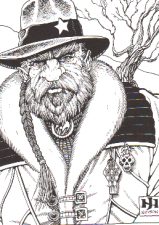
Dwarf
(Homo sapiens pumilionis) Identification: The average dwarf is 1.2 meters tall and weighs 54 kilograms. His coloration is usually pinkish-white or light tan, but may be as dark as ebony. Female dwarfs have 2 mammae, and all dwarfs have 32 teeth. Dwarf legs are disproportionately short making them poor runners. Their torsos are wide, with great breadth at the shoulders, endowing the subspecies with increased arm strength. Their body hair is well-developed and head hair profuse; males have extensive facial hair. The dwarf nose tends to be large and long, and the ears slightly pointed.
Habitat: This subspecies prefers artificial or natural caverns in wilderness areas. In urban environments, dwarfs show a preference for dwelling in basements or subbasements.
Habits: Dwarfs may be active by day or night. Their diet is omnivorous. Populations form small family groups, and they show isolationist tendencies, small enclaves are found in communities all over the world. Their life span is unverified, but predictions based on metabolic rates run to more than a hundred years. Their breeding season is unrestricted. The gestation period is 284 days.
Young: One. Birth weight is 5.6% of mother's weight. Suckling time is more than 15 months.
Commentary: With eyes sensitive to the infrared spectrum, a dwarf's activity is unrestricted underground as above. Dwarf phenotypes also show an increased resistance to pathogens.
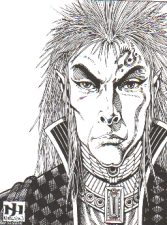
Elf
(Homo sapiens nobilis) Identification: The height of the typical elf is 1.9 meters, and his weight is 72 kilograms. Coloration is pale pink to white or ebony. The females have 2 mammae, and all elves have 32 teeth. Nobilis is more slender than sapiens and has a lighter build, though he bone structure and musculature are equally string. The slenderness is exaggerated in nobilis of Polynesian and Australian aboriginal origin. Elven body hair is sparse, but is usually luxuriant and extremely fine. Elven hair is usually straight or slightly wavy and is almost always worn long. There are also several populations showing tightly curled head hair, however. The eyes are almond shaped; in darker-skinned nobilis they are slightly protuberant. The ears come to a definite point.
Habitat: in urban areas, elves inhabit standard human structures. In wilderness areas, they prefer to live in structures built of natural materials or living plants.
Habits: Elves are nocturnal beings. Their diet is vegetarian. They tend to live in small groups, preferably apart from the rest of humanity. The elf life expectance is unverified, with possible life spans of several hundred years, but metabolic studies are inconclusive. The elven-breeding season is unrestricted. Gestation is 360 days.
Young: Usually one, though twins are common. In such cases, only one is nobilis, with the other usually nonviable. Birth weight is 5.2% of mother's weight. Suckling time is more than 25 months.
Commentary: Elven eyes are heavily endowed with rod structures. This allows them to see in dim light far better than sapiens.
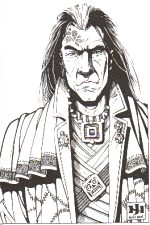
Human
(Homo sapiens sapiens)
Habitats: Humans prefer to dwell in roofed structures.
Habits: Most humans prefer daytime activity. Their diet is omnivorous. Human populations live in small family groups, pairs of adults, or alone. The worldwide average human life span is 55 years. The breeding season is unrestricted. Gestation is 266.5 days.
Young: Usually one. Twins are uncommon and higher multiples are rarer. Birth weight is 5.5% or mothers weight. Suckling time is more than twelve months. An individual offspring may be a subspecies of robustus or ingentis and may express (undergo Unexplained Genetic Expression) at puberty.
Commentary: As the form of Homo sapiens present throughout recorded history, Homo sapiens sapiens is sometimes called "normal", as distinguished from other subspecies. This is not a scientific term, as any subspecies is just as normal as another. In common usage, the term differentiates sapiens from the groups of "metahumans" whose existence has been recorded since 2011.
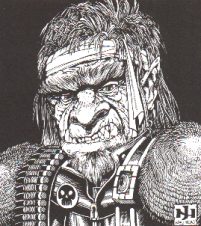
Ork
(Homo sapiens robustus) Identification: Orks are 1.9 meters tall and weigh 95 kilograms. Their skin coloration varies from pale pink to ebony. Ork bodies are proportioned similarly to that of sapiens, but robustus is more heavily built. Head hair is usually more prominent than the sapiens ethnic group from the individual robustus was derived. The ork nose tends to be broad and the lips thin. The ork skull has 32 teeth, with greatly enlarged lower canines. Ork females have 2 mammae.
Similar Species: Robustus, like ingentis, is highly variable in appearance, leading investigators to theorize that certain individuals or small communities are, in fact, other subspecies or other species entirely. This variety of types continues to mislead unwary researchers.
Habitat: Usually in roofed buildings.
Habits: Orks are active day and night, but seem to prefer the night. Their diet is omnivorous, but with a distinct preference for meat. Populations form large groups, often with a tribal structure. The typical life span appears to be between 35 and 40 years. Their breeding season is unrestricted. Gestation is 187 days.
Young: Ork mothers usually bear 4 children, but births of six or eight are not uncommon. Birth weight is 4.2% of mother's weight. Sucking times is more than seven months. Most newborns are obviously robustus, but may appear sapiens; 95% of the latter will express at puberty, which occurs around the age ten.
Commentary: The higher proportion of rod over cone structures in the ork's eyes allows enhanced low-light vision. Individuals expressing into robustus usually evidence negative psychological effects, with severe psychoses and aberrant behavioral patterns common. Individuals born robustus social normally.
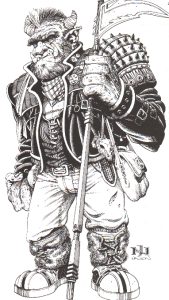
Troll
(Homo sapiens ingentis)
Similar Species: Some investigations believe that individuals or small communities of this subspecies are, in fact, other species entirely. Further investigations, including breeding studies, are required to confirm such hypotheses, as trolls are highly variable in appearance.
Habitat: Trolls who live in wilderness areas use caverns and converted structures such as bridges for their dwelling places. In urban areas, they prefer areas shunned by "normals", such as sewers or derelict buildings.
Habits: Trolls prefer nighttime activity. Their diet is omnivorous. Populations usually congregate in small groups, which often cohabit with subspecies robustus. Metabolic studies and direct observation indicate a life expectance of about 50 years. The breeding season is unrestricted. Gestation is 259 days.
Young: Usually one. Birth weight is 2.5% of mother's weight. Suckling time is more than 15 months.
Commentary: the sensitivity of troll eyes to the infrared portion of the spectrum allows a troll almost unrestricted activity after dark. Expression from sapiens to ingentis adversely affects an individual's mental condition, often resulting in psychosis and aberrant behavioral patterns. Individuals born as ingentis do not experience this trauma and socialize normally.